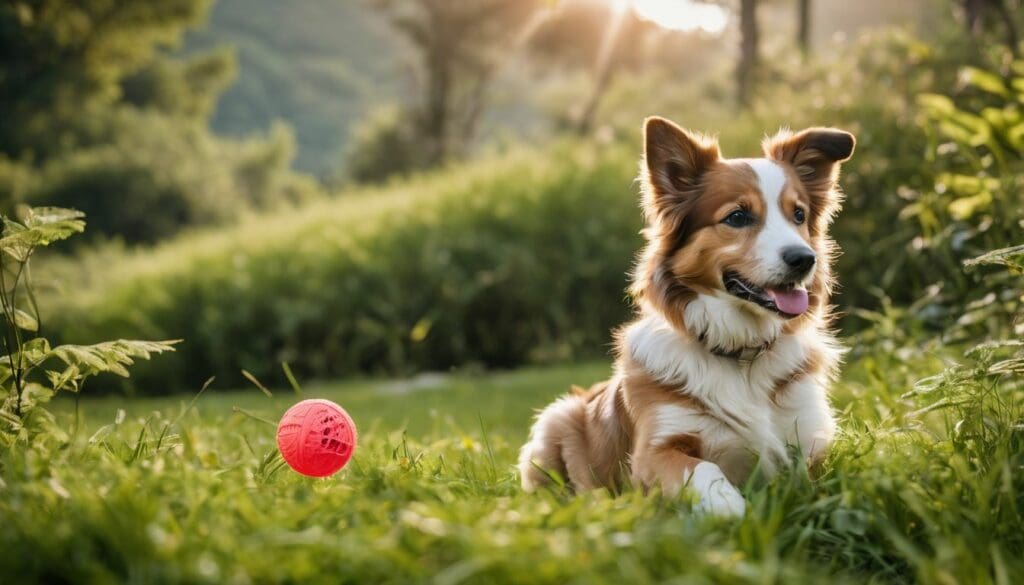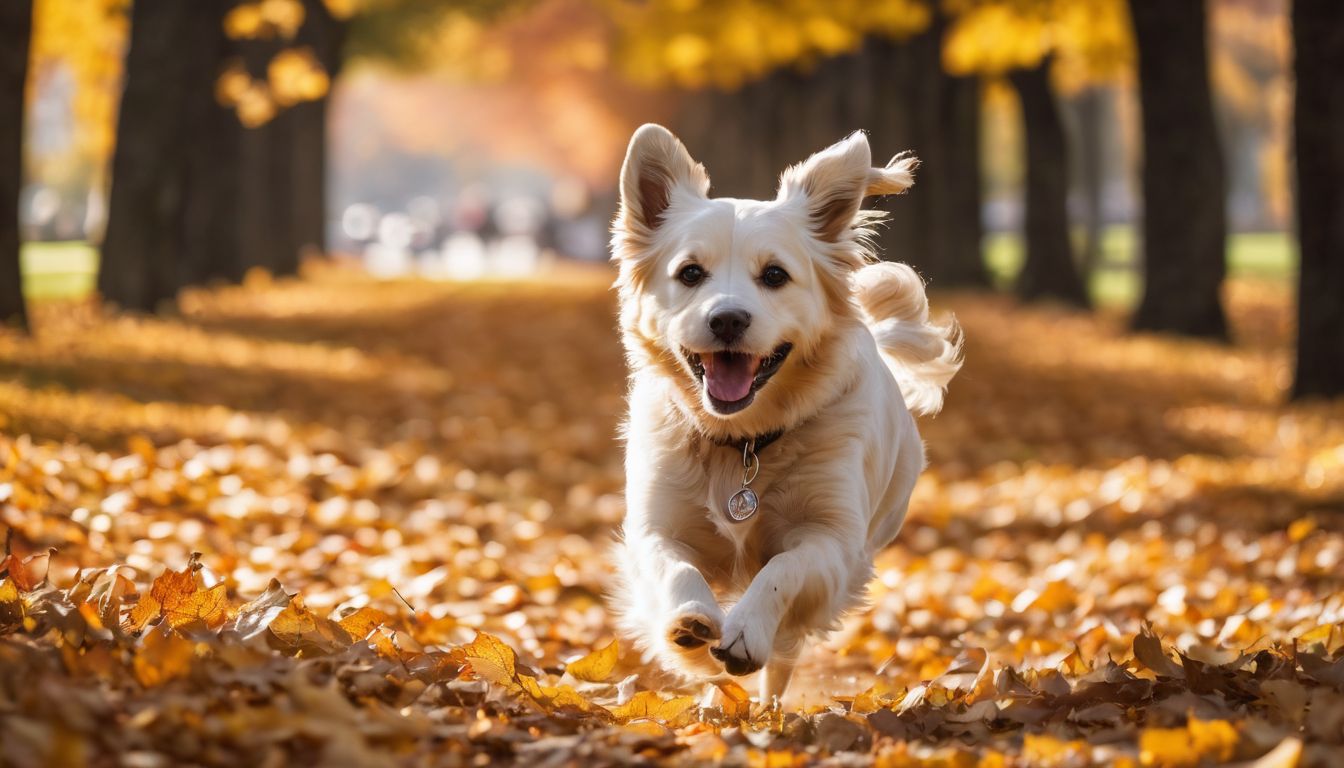As pet owners, we all want the best for our furry friends, but often forget their pawprints stretch beyond our homes to the planet. Surprisingly, a dog’s carbon footprint can be as large as that of an average SUV.
This article offers practical tips to shrink this ‘pawprint’, helping both your pet and the environment thrive. Read on to make greener choices together!
Key Takeaways
- Pets’ diets, particularly meat-based foods, have a significant environmental impact; opting for sustainable options like plant or insect-based proteins can help lower this.
- Proper disposal of pet waste is crucial; using biodegradable bags and eco-friendly kitty litter alternatives such as corn or wheat reduces pollution.
- Grooming pets with non – toxic products and choosing accessories made from sustainable materials like bamboo keep pets clean without harming the environment.
- Responsible pet ownership includes controlling the pet population through spaying/neutering, which helps manage their collective carbon footprint.
- Supporting animal welfare organisations contributes to wider conservation efforts while promoting ethical and environmentally friendly practices in pet care.
Understanding Your Pet’s Carbon Pawprint
Your pet’s carbon pawprint is influenced by factors such as their diet, waste management, and grooming products. It’s important to be aware of the environmental impact of pet ownership in order to make more sustainable choices for your furry friend.
Factors that contribute to carbon pawprint
Pets leave a carbon pawprint just like humans do. This footprint shapes the environment and affects the planet’s health. Here are several factors that play a part:
- The type of food pets eat has a significant impact. Production of meat – based diets, especially beef, contributes to greenhouse gas emissions due to livestock rearing.
- How pet food is packaged matters as well. Plastic bags and cans can end up in landfills if not properly recycled, adding to waste problems.
- Pet waste also adds to their carbon footprint. When not disposed of correctly, it can release harmful methane gases into the atmosphere.
- Energy used for pet care essentials, such as heating aquariums or washing bedding, increases overall household energy consumption.
- Accessories and toys contribute when they’re made from non – recyclable materials or transported long distances.
- The overpopulation of pets strains resources and intensifies their collective environmental impact.
Impact on the environment
Pets have a significant impact on the environment due to their carbon emissions, waste production, and consumption of resources. Their diet contributes to carbon footprint, especially when high levels of meat are involved.
By choosing sustainable and eco-friendly pet food options and reducing meat intake, you can lower your pet’s environmental impact while promoting more sustainable agricultural practices.
Additionally, proper waste management is crucial in minimising the environmental impact of pets. Ensuring the responsible disposal of pet waste and considering alternatives to traditional kitty litter can help reduce pollution and conserve natural resources.
Eating for the Planet
When it comes to reducing your pet’s carbon pawprint, choosing sustainable and eco-friendly pet food is crucial. Consider options that use minimal packaging and have a low environmental impact.
https://www.youtube.com/watch?v=N2HiuXOp2TE
Choosing sustainable and eco-friendly pet food
When selecting sustainable and eco-friendly pet food, consider the following options to reduce your pet’s carbon pawprint:
- Opt for plant-based or insect-based protein sources: Look for pet foods made with sustainable protein sources such as plant-based proteins like lentils, chickpeas, or peas. Insect-based proteins like crickets and mealworms are also eco-friendly and nutritious alternatives.
- Choose organic and locally sourced ingredients: Select pet foods made with organic, locally sourced ingredients to support sustainable agriculture practices and reduce the carbon footprint associated with transportation.
- Avoid additives and by-products: Opt for pet foods that are free from artificial additives, preservatives, and by-products, as these can have a negative impact on the environment and may contribute to a higher carbon pawprint.
- Consider packaging sustainability: Look for pet foods packaged in environmentally friendly materials such as recyclable or biodegradable packaging to minimise waste and environmental impact.
- Support ethical and eco-friendly brands: Choose pet food brands that prioritise sustainability, ethical sourcing practices, and environmental responsibility in their production processes.
- Reducing meat intake
Reducing meat intake
When considering your pet’s carbon pawprint, reducing their meat intake can have a significant impact on the environment. Opting for sustainable and eco-friendly pet food options that incorporate plant-based proteins and fewer meat ingredients can help lower their animal diet carbon footprint.
This simple change in their diet choices contributes to climate-friendly pet care and supports environmentally conscious practices without compromising their nutrition.
Opting for sustainable and eco-friendly pet food options that incorporate plant-based proteins and fewer meat ingredients can help lower their animal diet carbon footprint. This simple change in their diet choices contributes to climate-friendly pet care and supports environmentally conscious practices without compromising their nutrition.
Waste Management
When it comes to waste management, it’s important to properly dispose of your pet’s waste and consider alternatives to traditional kitty litter for a more eco-friendly approach.
Properly disposing of pet waste
Dispose of pet waste in designated dog waste bins or compost it at home using a pet waste composter.
Alternatives to traditional kitty litter
- Biodegradable litter made from natural materials such as maize, wheat, or pine.
- Recycled paper pellets that are highly absorbent and eco-friendly.
- Silica gel crystals that minimise odours and reduce waste.
- Plant – based litter made from sustainable resources like bamboo or grass.
- Flushable litter that dissolves in water, reducing landfill waste.
- DIY options such as using shredded newspaper or wood shavings.
- Litter made from renewable resources like coconut husks or walnut shells.
- Innovative litter products that offer reduced environmental impact through biodegradability and sustainability.
Eco-Friendly Grooming and Cleaning
Use non-toxic grooming and cleaning products for your pet, and choose sustainable materials such as bamboo or recycled materials for their accessories. Taking eco-friendly measures when it comes to grooming and cleaning can significantly reduce your pet’s carbon pawprint.
Using non-toxic products
When choosing pet grooming and cleaning products, opt for non-toxic options that are safe for both your pet and the environment. Look for environmentally friendly and animal-friendly grooming products that are free from harmful chemicals and synthetic fragrances.
- Select shampoos and conditioners made from natural, biodegradable ingredients to minimise their impact on water systems.
- Use non – toxic cleaners for pet bedding, toys, and other surfaces to reduce air and water pollution.
- Seek out eco-friendly flea and tick treatments that use plant-based ingredients instead of harsh chemicals.
- Consider using natural remedies like baking soda or vinegar for odour control instead of chemical sprays or deodorisers.
Sustainable materials
After using non-toxic products, consider the use of sustainable materials for your pet’s accessories and items to further reduce their carbon pawprint. Here are some eco-friendly options:
- Renewable bamboo: Choose pet bowls, litter boxes, and grooming tools made from bamboo, a fast-growing and sustainable material.
- Recycled materials: Look for pet beds, toys, and collars made from recycled plastic or fabrics to minimise waste and support recycling efforts.
- Organic cotton: Opt for pet bedding and clothing made from organic cotton, which reduces pesticide use and promotes sustainable farming practices.
- Hemp-based products: Consider hemp-based leads, collars, and harnesses as an environmentally friendly alternative to traditional synthetic materials.
Responsible Adoption and Ownership
Controlling the pet population through responsible breeding and spaying/neutering, as well as supporting animal welfare organisations, can help reduce the carbon pawprint of pets. By making informed decisions about pet ownership, individuals can contribute to a more sustainable environment for all.
Controlling the pet population
Controlling the pet population is crucial for reducing carbon pawprints. Supporting spaying and neutering programmes helps prevent overpopulation, which in turn decreases the environmental impact of pet ownership.
By adopting from shelters or rescue organisations rather than purchasing from breeders, you can support responsible pet population control and give homeless animals a new lease on life.
Furthermore, education about responsible breeding practices and the importance of adoption can help raise awareness about pet overpopulation issues. Encouraging others to consider adoption as their first choice when getting a pet also contributes to managing the growing number of pets in need of homes while making environmentally conscious decisions for sustainable pet ownership.
Supporting animal welfare organisations
When considering pet ownership from an environmentally conscious perspective, supporting animal welfare organisations becomes crucial. These groups play a vital role in promoting ethical treatment, rescuing animals in need, and advocating for sustainable pet care practices.
By contributing to these organisations or volunteering time, individuals can actively participate in creating a more compassionate and eco-friendly world for all creatures.
In addition to reducing your pet’s carbon pawprint through daily choices, backing animal welfare organisations also contributes to the larger mission of conservation and environmental protection.
Conclusion
In conclusion, reducing your pet’s carbon pawprint is crucial for environmental conservation. Choosing sustainable pet food and eco-friendly grooming products can significantly minimise their impact.
Responsible ownership and waste management also play a vital role in creating a more climate-friendly pet lifestyle. By making these conscious choices, we can all contribute to a greener and healthier planet for both humans and animals alike.
FAQs
1. What does reducing your pet’s carbon pawprint mean?
Reducing your pet’s carbon pawprint involves choosing eco-friendly pet products, minimising waste from pets, and making sustainable food choices to lower the environmental impact of keeping a pet.
2. How can I find environmentally friendly supplies for my pet?
You can search for green pet products and eco-conscious pet supplies that focus on being low-impact and are made with sustainable materials to support environmentally friendly pet care.
3. Is it possible to have climate-friendly grooming products for pets?
Yes, you can choose animal-friendly grooming products that are designed to be eco-friendly and contribute towards a more climate-conscious approach to taking care of your pets.
4. Can I make my pet care routine more eco-conscious?
Absolutely! By using sustainable pet food options, engaging in proper pet waste management, and opting for carbon-neutral or low-impact items, you create an eco-friendly lifestyle for both you and your furry friend.
5. Why is it important to consider sustainable options when feeding my pet?
By selecting sustainable food choices over conventional alternatives, not only do you provide healthier meals but also take positive steps in reducing the overall carbon emissions associated with traditional animal agriculture practices.





